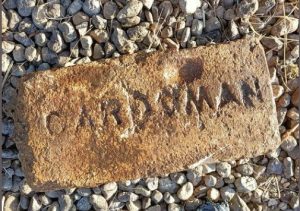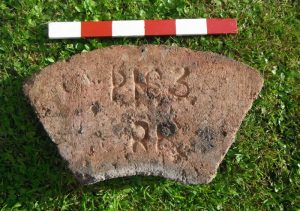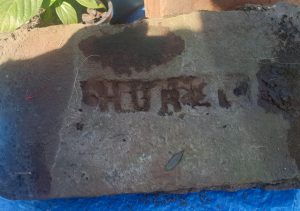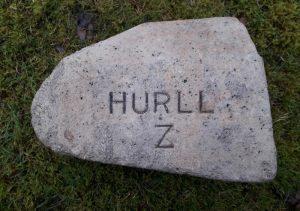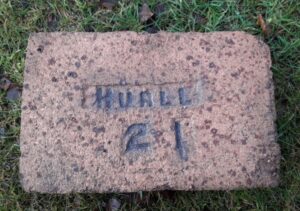Cardowan Fire Clay Works, Stepps, Glasgow – This should be read in conjunction with the post on the Heathfield Fireclay Works.
Canmore
Cardowan and Heathfield Works. The first of these works, belonging to Messrs. John Young and Son, was built in 1852 by Messrs. John Hurll and John Young, previous to that time of the Garnkirk Company. The clay is the Garnkirk seam and is of much the same character as the Stourbridge clay. The Heathfield Works were acquired about 1860 from Messrs. Miller and Ferguson (which see) and were largely extended and altered, and improved machinery introduced. The clay was won at 350 feet, passing through a solid bed of freestone of 120 feet, giving off much water; the seam itself is known as the Glenboig seam of clay, as it was first wrought at the ” Glenboig Works,” with which Mr Young was also till quite recently, a partner. At the “Cardowan Works” the firm manufacture the usual varieties of fire-bricks, blast-furnace blocks, gas retorts and fittings, vases, garden edgings, and plain and ornamental chimney shafts. At the ” Heathfield Works,” they produce fire-bricks, and vitrified salt-glazed pipes for sewerage and water purposes, and invert sewer blocks and all the usual salt-glazed articles. In 1874 Messrs. Hurll and Young dissolved the partnership; Mr Young, along with his sons John and Robert, being now the sole proprietors. The product of these works when in full work is about 20,000 fire-bricks per day and about 1,500 yards of pipes weekly.
Adjacent to Mark Sprot’s extensive fireclay deposits of Garnkirk were others owned by Dr James Jeffray of Cardowan, Professor of Anatomy at Glasgow University for the very long period 1790-1848. In 1832 Professor Jeffray’s fireclay bricks were said to be “not let”, but soon afterwards a fireclay works was established at Heathfield by Peter Ferguson to make use of these minerals. By 1834 Ferguson had a store at the Garnkirk & Glasgow Railway terminus at Townhead, Glasgow, for his Heathfield firebricks and tiles. About 1846 the Heathfield’s firm’s name was changed from Peter Ferguson & Co. to Ferguson, Miller & Co.
1851 – ‘Garnkirk Fireclay by G Quail’ – Neighbouring Fireclay Works: Cardowan. One of the most significant figures during the early years of fireclay manufacturing in Scotland was John Hurll, who seems to have come over from Ireland about 1935 to work for the Garnkirk Coal Company. In 1851 he was described as ‘brickyard operations manager’ at the Garnkirk Works. Soon afterwards he joined forces with John Young to establish fireclay works at Cardowan.
Below – 1857 – Cardowan Fireclay Works and Fireclay Pit.

1858 – 1859 – Cardowan Brickworks – Moodiesburn, Glasgow. Messrs Hurll and Young and Depot St Rollox.
Below – 1858 – Cardowan Fire Clay Works.

1858 – Mineral Statistics of the United Kingdom of Great Britain and Ireland for 1858 – East Cardowan, clay of coal measures. Name of freeholder – John Jeffrey. Manufacturer – Hurl(l), Young & Co. Manufacture – Bricks, covers, flooring tiles and blocks. Estimated 6000 tons annually.
Below – 1861 – Hurll and Young Cardowan, Garnkirk.
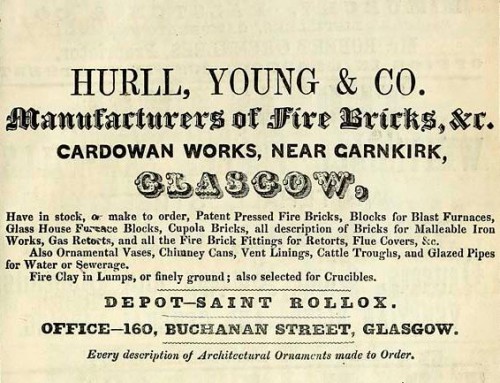
25/07/1861 – Glasgow Herald – Notice – We advance cash to our men as hitherto and pay John Jenkins, George Allan and Patrick McAteer daily or hourly if required. Hurll, Young and Co. Cardowan Fire Brick Works 24/07/1861.
22/02/1862 – Renfrewshire Independent – Capture of daring burglars … a pair of boots were also found which were identified as having been stolen from a store at Crow Road, Garnkirk belonging to Mr John Hurrel (Hurll), of Cardowan Brickworks …
Below – 02/03/1865 – Inverness Courier – Heathfield and Cardowan Fire Brick and Sewerage Pipe Works near Garnkirk. Advert Hurll, Young & Co.

1870 – Invoices – Hurll, Young & Co, Heathfield and Cardowan Fire Brick Works near Garnkirk. Office 188 Buchanan St, Glasgow. Deport St Rollox. Manufacturers of sewerage pipes, fire bricks, gas retorts, ornamental chimney cans, flue covers, paving tiles &c.
1873 – ‘Garnkirk Fireclay by G Quail’ – The Hurll, Young & Co partnership was dissolved. John Hurll moved to Glenboig to concentrate his interests there while John Young established the firm of John Young and Sons to take charge of Heathfield and Cardowan …
20/02/1874 – Glasgow Herald – Glasgow, 18th February 1874. The copartnery concern of Hurll, Young & Company, coalmasters and sewage pipe and fire brick manufacturers, here, and at Drumgray, Heathfield and Cardowan, of which the subscribers were the sole partners has been dissolved by mutual consent as on 29th November last. The subscriber Mr Youn, who continues the business, is authorised to receive and discharge all debts due to and he will pay all debts due by, the dissolved company. John Hurll and John Young …
Below – 1875 – John Young and Sons, Heathfield and Cardowan.
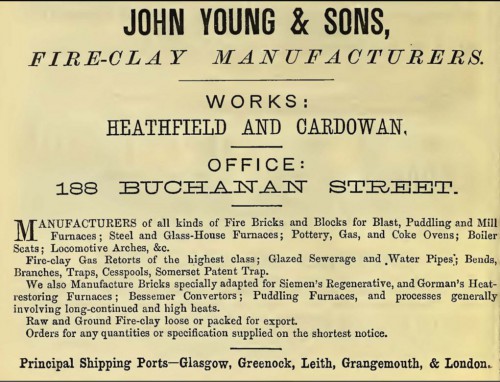
22/06/1875 – The Sydney Morning Herald, NSW – Cardowan, Garnkirk firebricks – Mason Brothers.
1876 – John Hurll, Cardowan Brickworks, Moodiesburn.
1877 – John Hurll, Cardowan Brickworks, Moodiesburn.
20/04/1878 – Parbury Lamb & Co, importers, Brisbane – Cardowan Firebrick squares for sale.
14/09/1878 – The Sydney Morning Herald, NSW – Now landing aboard The Craigard 20,000 Cardowan firebricks for Mason Brothers.
1880 – 1882 – Invoice – Various invoices. John Young & Sons, Heathfield and Cardowan Fire Brick Works near Garnkirk. Office 188 Buchanan St, Glasgow. Deport St Rollox. Manufacturers of sewerage pipes, fire bricks, gas retorts, ornamental chimney cans, flue covers, paving tiles &c.
14/02/1880 – Maryborough Chronicle, Wide Bay and Burnett Advertiser – Parbury, Lamb and Co, Brisbane, importers – Firebricks Cardowan squares.
21/07/1883 – The Brisbane Courier – Commercial markets Cardowan bricks fell at £8.10s and Gartcraig £8.5s and Heathery Knowe £7.15s.
Below – 01/05/1884 – Clyde Bill of Entry and Shipping list – Advert. John Young and Sons, Heathfield and Cardowan Works near Coatbridge.

1886 – John Young and Sons, Heathfield and Cardowan. Office 42 Bath Street, Glasgow.
Below – 25/05/1887 – Clyde Bill of Entry and Shipping List.

03/06/1887 – Glasgow Herald – The following circular has been issued. The firm (John Young Sons and Co) has been long engaged in the fire brick and tile trades and has also been to some extent in the coal trade. It is understood that the liabilities reach a good figure, yet as their situation has been in a measure known for a time, their facilities have of late been contracted.
42 Bath Street, Glasgow 31/05/1887
Dear Sir, it is with extreme regret that we have to announce that we have this day been compelled to suspend payment. We have placed our works into the hands of Messrs Kerr, Andersons, Mair and Main, C.A, Glasgow by whom a statement of our affairs will be made up and submitted to a meeting of our creditors to be held in their chambers, 142 West George Street, Glasgow upon Tuesday 5th June at 12 noon, which meeting you are invited to attend. To facilitate the preparation of this statement please favour us by the return of post with a statement of your account to date. Your obedient servants John Young Sons and Co.
1887? – ‘Garnkirk Fireclay by G Quail’ – John Young & Sons went into liquidation in the late 1880s and the works were purchased by John Faill of A & J Faill, contractors and quarrymasters, Glasgow. Trading continued under the style of “Heathfield & Cardowan Fire Clay Co.” and the works were considerably extended …
05/09/1888 – Kirkintilloch Herald – The Heathfield and Cardowan Brickworks, which have been at a standstill for over 12 months, have again started operations.
Below – 1889 – Heathfield and Cardowan Fire Clay Co.

13/01/1890 – Glasgow Herald – John Young & Co V Heathfield and Cardowan Fire Clay Company. Lord Kincairney heard counsel in a note by John Young & Co, fire clay goods manufacturers, 42 Bath Street, Glasgow to interdict the Heathfield and Cardowan Fire Clay Company, 5 Dixon Street, Glasgow from selling fire clay bricks stamped with the name Cardowan other than goods manufactured by the complainers. In 1888 the respondents became tenants of the lands of Heathfield having purchased the business of John Young & Co from the trustees on the sequestrated estates of that firm. At the date of the sequestration, the fire clay in the lands of Cardowan in so far as let to them had been exhausted and the respondents on taking up the business issued a circular to their customers intimating that the brand on all bricks manufactured by them would in future be that of Heathfield. In July 1888, the complainers registered the words ‘Youngs’ and ‘Cardowan’ as their trademarks. Recently it came to the knowledge of the complainers that the respondents were stamping their goods with the same trademark as that used by the complainers, to the injury of the latters business. The respondents in their answers state that the fire clay in the lands of Cardowan never was exhausted by the sequestrated firm and that it was at present being worked by the respondents. The word ‘Cardowan’ had been used by John Young, Sons and Co in their business long before it was registered by the complainers. The word ‘Cardowan’ is a geographical term applicable to the works belonging to the respondents and the estates on which their works are situated and the complainers have no right or interest of any kind in any property or fire clay in connection with such works or estate. After hearing counsel, his Lordship passed the note for trial of the case …
11/06/1890 – Glasgow Herald – John Young & Co V Heathfield and Cardowan Fire Clay Company. A Proof was to have been led today in an action by John Young & Co., fire clay goods manufacturers, 42 Bath Street, Glasgow, to interdict the Heathfield and Cardowan Fire Clay Company, 5 Dixon Street, Glasgow, from selling fire clay bricks stamped with the name Cardowan other than goods manufactured by the complainers. In 1888 the respondents became tenants of the lands of Heathfield, having purchased the business of John Young, Sons & Co., from the trustee on the sequestrated estates of that firm. At the date of the sequestration the fire clay in the lands of Cardowan in as far as let to them had been exhausted, and the respondents on taking up the business issued a circular to their customers intimating that the brand on all bricks manufactured by then would in future be that of Heathfield. In July 1886, the complainers registered the words “Youngs” and “Cardowan” as their trademarks. Recently it came to the knowledge of the complainers that the respondents were stamping their goods with the same trademark as that used by the complainers, to the injury of the latter’s business. The respondents in their answers state that the fire-clay lands of Cardowan never was exhausted by the sequestrated firm and that it was at present being worked by the respondents. The word Cardowan had been used by John Young, Sons & Co. in their business long before it was registered by the complainers. The word Cardowan is a geographical term applicable to the works belonging to the respondents and the estate on which their works are situated and the complainers have no right or interest of any kind in any property, or in connection with such works or estate. When the proof was called today it was intimated that the action had been settled.
16/07/1890 – The Scotsman – John Young & Co V Heathfield and Cardowan Fire Clay Company. John Young & Co, fireclay goods manufacturers and merchants, 42 Bath Street, Glasgow, the registered proprietors of the trademark ‘Cardowan’ sought in this action to have the Heathfield and Cardowan Fireclay Company, Heathfield, Garnkirk, Lanarkshire and 5 Dixon Street, Glasgow, interdicted from using that trademark. In the other action, the Cardowan Company petitioned to have Young & Company’s name removed from the register of trademarks as owners of the ‘Cardowan’ trademark. Both actions have been taken out of Court, the Cardowan Company having purchased the trademark from Young & Co, each party paying their own expenses …
31/12/1890 – Kirkintilloch Herald – Chryston. The Sabbath schools in connection with the Parish Church had their usual Christmas treat the evening of Wednesday. Mr John Faill, of Heathfield and Cardowan works, occupied the chair. Addresses were delivered by the Chairman, the Rev. W. Davidson, and Mr Forsyth, Langrigg. Songs were sung by several of the teachers, and through the kindness of Mrs Finlayson, Garnkirk House, an abundance of creature comforts were provided for the children. A magic lantern entertainment was also given. The number of parents and children present was the largest that had ever attended the Christmas festival in the church. This, we believe, is owing to the accession of Heathfield Sunday school, recently opened by Mr Davidson, whose indefatigable exertions in that quarter are meeting with great success.
28/01/1891 – Glasgow Herald – Wanted to purchase. Triping and dross, various qualities. Apply Heathfield and Cardowan Fireclay Company. 52 Robertson Street.
08/03/1893 – Kirkintilloch Herald – The first social meeting of the employees of Heathfield and Cardowan Fireclay Works was held in the Drill Hall, Muirhead on the 28th …
1894 – ‘Garnkirk Fireclay by G Quail’ – George Cleland, later manager at Heathfield Works started in the office at Cardowan in 1894. During the mid-1960’s he recorded his memories of Cardowan seventy years later. (Note – SBH – Does anyone have a copy of these memoirs or know where to find them?)
21/03/1894 – Kirkintilloch Herald -Works social at Chryston. The second annual soiree and concert of the employees of Heathfield and Cardowan Fire Clay Co. was held in the Drill Hall, Muirhead on Thursday evening. Mr John Faill occupied the chair, supported by Rev. Mr Davidson, Dr Lamont, Messrs. James Faill, Baird, Nicol, Smith, Marshall, Jarvie, Rigg, Monaghan, Montgomery, Tagg, Strachan, &c. There was a very large attendance. After tea, the Chairman delivered an address. He first spoke of the beneficent purposes which such gatherings, including as they did the ladies, served, and expressed the hope that all would thoroughly enjoy themselves. Heathfield Works was the oldest fire clay work in the district, having done duty first as a pottery. Its history extended back over sixty years. The smoke which belched forth from its many stalks was a fulfilment of the Scottish toast- “Long and well may your lums reek.” and was at once an evidence and a foretaste of a successful commercial undertaking. Cardowan had a later history, but sought to emulate the reek and growth of her elder sister, and, indeed, was now undergoing considerable extension. In conclusion, he referred to the cordial relations which existed amongst them, and that past experience, present position, and future prospects were all favourable and propitious and furnished occasion for mutual thankfulness and congratulation. (Applause.) During the evening a capital concert was sustained by an able company of professionals, and appropriate remarks were made by the Rev. Mr Davidson and Mr Baird. An assembly followed.
Below – 1897 – Cardowan Fire Clay Works.

21/02/1899 – Dundee Advertiser – The personality of Mr John Hurll, Woodneuk, Gartcosh has been returned at £119,495.
10/09/1902 – Kirkintilloch Herald – Railway accident. An accident which might have been attended with serious results at Cardowan Fireclay Works the Caledonian Railway Saturday last. The Garnkirk engine was executing the shunting operations at that work. About 1.30 it was shoving a number of waggons filled with fireclay into the siding when the first one left the rails at the crossing. Before the engine could be brought to a standstill, altogether three waggons had left the rails, one being overturned, the other two blocking the up line. The down line was clear, however, so that the traffic did not suffer any serious detention, although some trains were about half an hour late. In a short time, the line was completely cleared and the wreckage was removed Sunday.
29/10/1902 – Kirkintilloch Herald – Owing to a dull trade the Cardowan Fire Clay Works close today for an indefinite period. The fire clay trade has been very dull for a considerable time back with the unfortunate result that the Heathfield and Cardowan Fire Clay Co have found it necessary to close their works at Cardowan for some time. Forty or fifty men will be thus thrown idle at an exceptionally dull period of the year.
c. 1902 – ‘Garnkirk Fireclay by G Quail’ – From the mid-1870s until it closed in 1902, Cardowan Fireclay Works was under the same management as Heathfield (Fire Clay Works) and saw the same changes … (Note – SBH – It is assumed that the Cardowan Fireclay Works never re-opened after the closure referred to in the article dated 29/10/1902).
10/11/1909 – Kirkintilloch Herald – Engine stripping. On Tuesday, the 2nd November, about eleven o’clock at night, two men were proceeding to their homes at Cardowan Brickworks, when they observed light in the window of the engine room of the works. As the works have been standing idle for some time, their suspicions were aroused and they went in search of the police. On arriving at the Cumbernauld Road they were met by two Muirhead, the Stepps, and the Millerston constables, whom they apprised of their suspicions. The band then made their way back to the works, and, looking through the window, observed a man busy at work stripping the brasses off the engines. The constables surrounded the building, leaving no loophole for escape, and when the man was leaving, apparently satisfied that he had made a good haul, he was caught and conveyed to the lock-up at Muirhead. The sequel took place on Thursday, when the culprit, William Turner, alias Stevenson, of no fixed abode, was brought before the Sheriff. He pled guilty to the charge, and, having six previous convictions, was sentenced to four months imprisonment.
Below – 1910 – Cardowan Fire Clay Works – Disused.
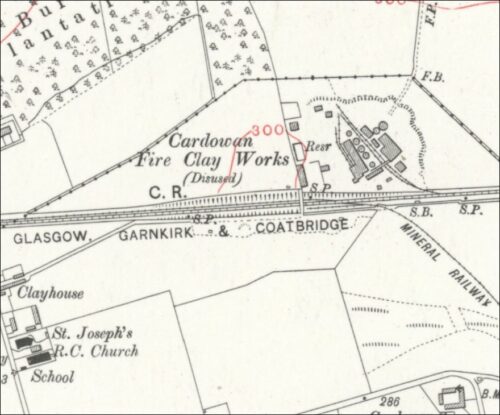
Below – 1910 – Cardowan Fire Clay Works – Disused.

1912 – 1913 – J Young and Co, fire clay manufacturers, 42 Bath Street, Glasgow.
24/04/1912 – Kirkintilloch – Meeting of the North and South Cadder Special Water Districts. A comprehensive article about the lack of domestic water at the houses owned by the Heathfield and Cardowan Fireclay Co Ltd at their employee houses at Heathfield Square and the occupied houses on the disused Cardowan Fire Clay Works site.
31/07/1917 – The Scotsman – Deaths. At Glasgow on 29th inst, John Faill of the Heathfield and Cardowan Fireclay Co Ltd, 3rd son of Peter Salmon Faill, 8 Glenorchy Terrace, Edinburgh.
Below – 1935 – Disused site of the Cardowan Fire Clay Works is still shown on the OS map.

03/12/1949 – Airdrie and Coatbridge Advertiser – Early years of brickmaking … It is not accurately known when the clay was first found at Glenboig nor is it known just when bricks were first made there. The industry goes back as far as 1834 if not further. Certainly, in 1894 John Hillcoat was engaged in brickmaking. He could not have made a great deal of progress because, as late as 1860, the total population was only 130. By this time some information was beginning to be obtained about the clay seams which, being named the Glenboig series of clays, have probably perpetuated the name of Glenboig in geological circles at least. About 1860 signs of the greatness to come were beginning to be seen when a new company, Thomson, McLean Company, acquired the right to work the minerals and were producing bricks on a much larger scale. Meanwhile, Messrs Hurll, Young & Co. were developing the industry at Heathfield and Cardowan (the Glenboig clays are visible in Cardowan pit, by the way), and in 1865 this firm took over from Thomson, McLean & Co. at Glenboig and was probably the first well-known Scottish firm of firebrick makers. This firm carried on till 1874 when, on dissolving the partnership, Mr John Hurll acquired the Glenboig Works while Mr Young went back to the Heathfield and Cardowan Works. As a member of the technical department of the present-day highly controlled mass-producing plant, I can read into these records of mixed fortune stories of high endeavour and bitter disappointment because the Glenboig minerals were never simple or straightforward, and even today, one hundred and twenty years after, we realise how much we do not know of the intriguing substance, fireclay …
July 1961 – Mr George Cleland Awarded M.B.E. Mr George Cleland, works manager of Heathfield and Cardowan Fireclay Co Ltd. Of Chryston, near Glasgow, was awarded the M.B.E. in this year’s Queens Birthday Honours List. Mr Cleland. who is 81 years of age has been with Heathfield and Cardowan for 66 years and is retiring in September of this year. He started works in the office of the firm’s Cardowan works in December 1894 and was transferred to the Heathfield works about a year later. He was appointed an assistant manager in 1910 and has been works manager since 1925. During his sixty-six years with Heathfield and Cardowan, Mr Cleland has seen many changes in methods of production and many changes in conditions and wages. In the 1890s bricks were all handmade, an average day’s work being 3,000 x 3 in. squares for a 10 1/4 hour day. Hours of work were from 6.15 a.m till 1 p.m. An average week’s wage for a moulder was about 25s. In those days too, all salt-glazed pipes were handmade faucets. Mr Cleland has always been confident that salt-glazed fireclay pipes would be preferred to concrete, even for the larger sizes and has been proud of the fact that Heathfield and Cardowan have always made all sizes up to 24in. diameter. The award of M.B.E. is an honour of which Mr Cleland is very proud and is an honour which he feels that he shares with the industry, the firm, and the workers with whom he has been associated over the last sixty-six years.
08/02/1963 – Wishaw Press – Ravenscraig keeps kilns busy. The new strip mill at Ravenscraig has been a blow against unemployment in Scotland – and not only among the ranks of the steelworkers. Two Scottish members of the National Salt Glazed Pipe Manufacturers Association have supplied many tons of fireclay pipes and fittings to the scheme. The pipes from four inches diameter upwards have been used in main and ancillary drainage networks. For the past five years Messrs Loudon and Russell Ltd of Morningside and the Heathfield and Cardowan Fireclay Co Limited, the two members, have been supplying fireclay pipe to the Ravenscraig Works. This has ensured full and continuous employment in both firms. Says Mr George Loudon, managing director of Loudon and Russell “During this time we have not only avoided laying off our people, but we have also taken on extra labour, and kept it”















